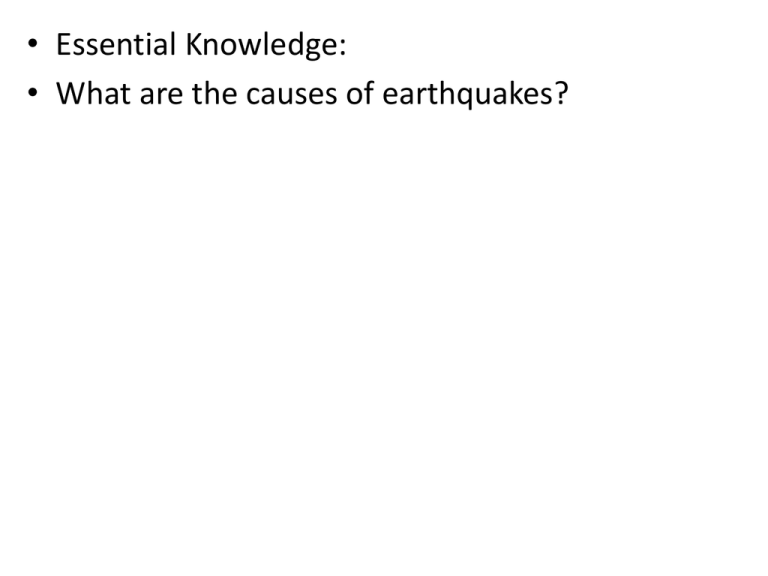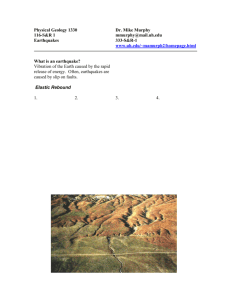UNIT 7 (2) PLATE TECTONICS, EARTHQUAKES AND VALCANOES
advertisement

• Essential Knowledge: • What are the causes of earthquakes? UNIT 7 (1) PLATE TECTONICS, EARTHQUAKES AND VALCANOES Earthquake is series of seismic waves or tremors in the earth’s crust. Caused when pressure builds up at edge of plates as they collide or slide past one another. Pressure released a huge amount of energy is released causing the plates to shake. Seismology-study of earthquakes. • Earthquake vocabulary: • Tremors-waver of seismic energy which spread from the focus. • Aftershocks- smaller tremors which may occur hours or days after original earthquakes. They can be extremely dangerous because they may cause already damaged building to collapse. • Focus- (Hypocenter)place deep in the earth’s crust where earthquake begins. • Epicenter- place on surface of earth, directly above focus. The tremors are strongest at this point. • Elastic Rebound-rocks bend until the strength of the rock is exceeded. • Rupture occurs & rocks quickly rebound to an Undeformed shape. Energy is released in waves radiate outward from fault. • Richter scale-used to describe strength of earthquake. • Seismograph-device that measures strength of earthquake. • Richter scale is logarithmic (6 is 10X stronger than 5). Magnitude and Energy Magnitude Energy 3 Explosive Power Example One ton of Explosives World Trade Center Collapse 2 1 Topple 50-meter tree One kilogram of explosives Head-on colision at 60 mph 0 Drop a car 10 meters Half stick of dynamite Very bad day skydiving -1 Impact of bullet One gram of explosives -2 Hammer blow -3 Dribbling a basketball 5. Magnitude and Intensity Magnitude and Energy Magnitude Energy Explosive Power Example 9 U.S. Energy Use for a month Alaska 1964 Indonesia 2004 8 U.S. Energy Use for a day San Francisco, 1906 7 6 5 One Megaton World Series Earthquake, 1989 U.S. Energy Use for Large Thunderstorm a minute One Kiloton 4 3 One ton of explosives 5. Magnitude and Intensity World Trade Center Collapse Seismic waves-response of material to arrival of energy fronts released by rupture. 2 types body waves P and S Surface waves R and L Body Waves: P and S waves • Body waves – P or primary waves • fastest waves • travel through solids, liquids, or gases • compressional wave, material movement is in same direction as wave movement – S or secondary waves • slower than P waves • travel through solids only • shear waves - move material perpendicular to wave movement Surface Waves: R and L waves • Surface Waves – Travel just below or along the ground’s surface – Slower than body waves; rolling and side-to-side movement – Especially damaging to buildings How is an Earthquake’s Epicenter Located? Seismic wave behavior – P waves arrive first, then S waves, then L and R – Average speeds for all these waves is known – After an earthquake, the difference in arrival times at a seismograph station can be used to calculate the distance from seismograph to the epicenter. How is an Earthquake’s Epicenter Located? Time-distance graph showing average travel times for Pand S-waves. Farther away a seismograph is from e focus of an earthquake, longer interval between arrivals of the P- and S- waves How is an Earthquake’s Epicenter Located? • Three seismograph stations are needed to locate epicenter of an earthquake • A circle where radius equals distance to epicenter is drawn • Intersection of circles locates epicenter • Intensity – subjective measure of kind of damage done & people’s reactions to it – isoseismal lines identify areas of equal intensity • Modified Mercalli Intensity Map – 1994 Northridge, CA earthquake, magnitude 6.7 How are the Size and Strength of an Earthquake Measured? • Magnitude – Richter scale measures total amount of energy released by an earthquake; independent of intensity – Amplitude of the largest wave produced by an event is corrected for distance and assigned a value on an open-ended logarithmic scale ESSENTIAL KNOWLEDGE: What are the factors contributing to earthquake damage, and other dangers associated with earthquakes. Can Earthquakes be Controlled? • Graph showing the relationship between the amount of waste injected into wells per month and the average number of Denver earthquakes per month • Some have suggested that pumping fluids into seismic gaps will cause small earthquakes while preventing large ones Faults- fracture along which blocks of crust on either side have moved relative to one another parallel to the fracture. Strike-slip-vertical fractures where blocks have mostly moved horizontally. Faults are classified by kinds of movement that occurs along them. Strike-slip left lateral fault. • Strike-slip right lateral fault. • Dip-slip faults-inclined fractures where blocks have shifted vertically • Dip-slip normal fault. Rock mass above an inclined fault moves down. • Dip-slip reverse fault. Rock above fault moves up. • Normal faults are caused by extension. • Reverse faults are caused by compression. • Reverse faults are often called thrust faults. • Earthquake Hazards. • Building collapse • Landslides • Fire • Tsunamis • • • • • Most dangerous buildings adobe house Unreinforced masonry. Reinforces concrete. Steel-frame. Small wood-frame house. • Tsunamis usually caused by submarine landslidestravel 400mph • They pass unnoticed at sea, but cause damage on shore. • There is a warning network around Pacific ocean, then can forecast arrival. • Damage from a Tsunamis depends on direction of travel of wave, harbor shape, bottom, and tide & weather. 5. Magnitude and Intensity Earthquake Fatalities Since 1800 7. Predicting earthquakes is not yet possible Are Earthquakes Getting More Frequent? 7. Predicting earthquakes is not yet possible Some Important Earthquakes 1755 - Lisbon, Portugal • Killed 70,000, Raised Waves in Lakes all over Europe • First Scientifically Studied Earthquake 1811-1812 - New Madrid, Missouri • Felt over 2/3 of the U.S. • Few Casualties 1886 - Charleston, South Carolina • Felt All over East Coast, Killed Several Hundred. • First Widely-known U.S. Earthquake Some Important Earthquakes 1906 - San Francisco • Killed 500 (later studies, possibly 2,500) • First Revealed Importance of Faults 1923 – Tokyo - Killed 140,000 in firestorm 1964 - Alaska • Killed about 200 • Wrecked Anchorage. • Tsunamis on West Coast. 1976 - Tangshan, China • Hit an Urban Area of Ten Million People • Killed 650,000 • History and earthquakes • In last 500 years more then 7 million people have died. • Destroyed economies and food sources. • Lisbon Earthquake 1755 -60,000 killed –ocean waves 30-40 feet above high tide level swamped city –fires burned 3 days.







